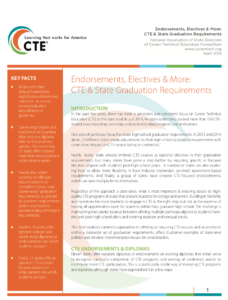The Strengthening Career and Technical Education for the 21st Century Act (Perkins V) gives states an opportunity to look at how Career Technical Education (CTE) intersects with other statewide policies related to graduation requirements. The new law maintains a focus on flexibility that allows states to determine how CTE works together with their strategies for competency-based education and policies for graduation. How can states create meaningful pathways to graduation? Check out the resources and policy profiles below to learn about the relationship between CTE and competency-based pathways, graduation requirements, and state approaches to these policies.
 REPORT: Building a Strong Relationship Between Competency-Based Pathways and Career Technical Education: This report by Achieve and Advance CTE lays out the leverage points between Career Technical Education (CTE) and Competency-Based Pathways (CBP) and provides guiding questions to help state and local leaders consider how CTE is, can and should be a part of their CBP strategies.
REPORT: Building a Strong Relationship Between Competency-Based Pathways and Career Technical Education: This report by Achieve and Advance CTE lays out the leverage points between Career Technical Education (CTE) and Competency-Based Pathways (CBP) and provides guiding questions to help state and local leaders consider how CTE is, can and should be a part of their CBP strategies.
 BRIEF: Endorsements, Electives & More: CTE & State Graduation Requirements: This Advance CTE brief explores common approaches to offering or requiring CTE courses and assessments within a statewide set of graduation requirements, offers illustrative examples of state-level policies and elevates implementation issues for consideration.
BRIEF: Endorsements, Electives & More: CTE & State Graduation Requirements: This Advance CTE brief explores common approaches to offering or requiring CTE courses and assessments within a statewide set of graduation requirements, offers illustrative examples of state-level policies and elevates implementation issues for consideration.
POLICY PROFILES
- Vermont: Flexible Pathways Initiative: Vermont’s Flexible Pathways Initiative provides flexibility for school districts and enables learners to pursue personalized pathways to college and career readiness that include dual enrollment and work-based learning opportunities.
- New Hampshire: Statewide Competency-Based Education: New Hampshire has a statewide competency-based education and assessment system, requiring all students to complete competency-based pathways to graduate and demonstrate their mastery of knowledge and skills, rather than just accumulate credits based on seat time.
Looking for additional resources? Please be sure to check out the Learning that Works Resource Center.

